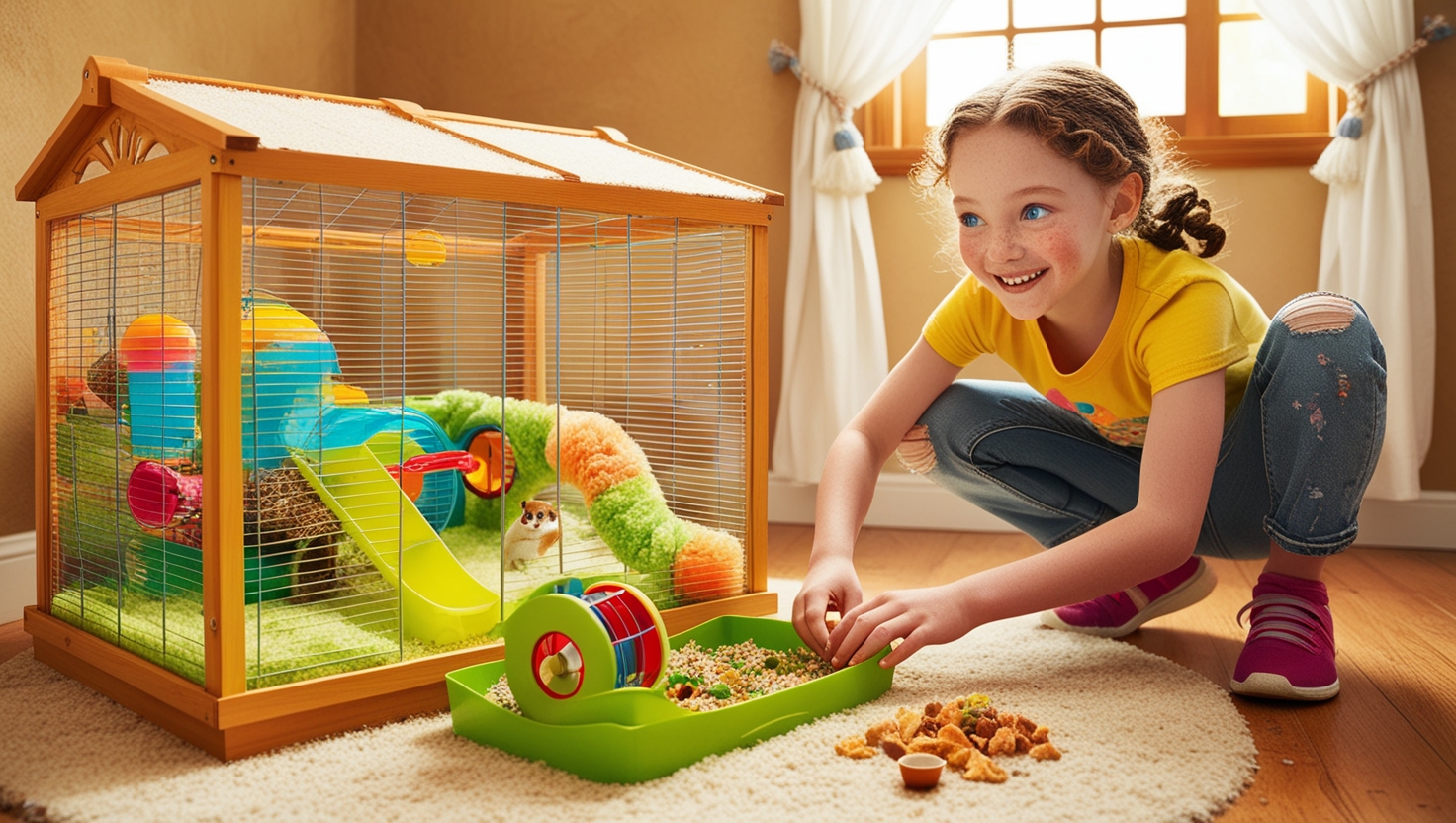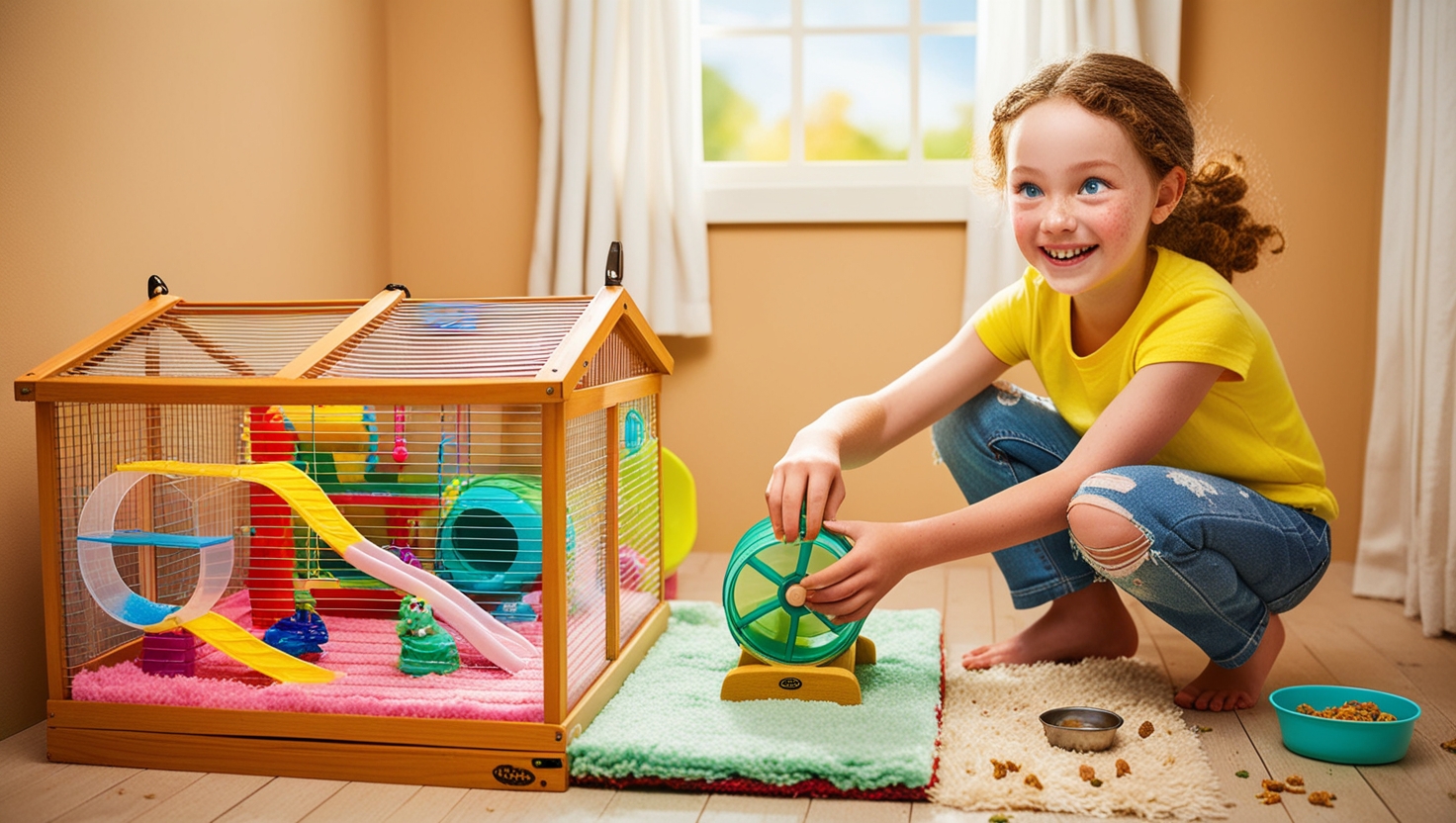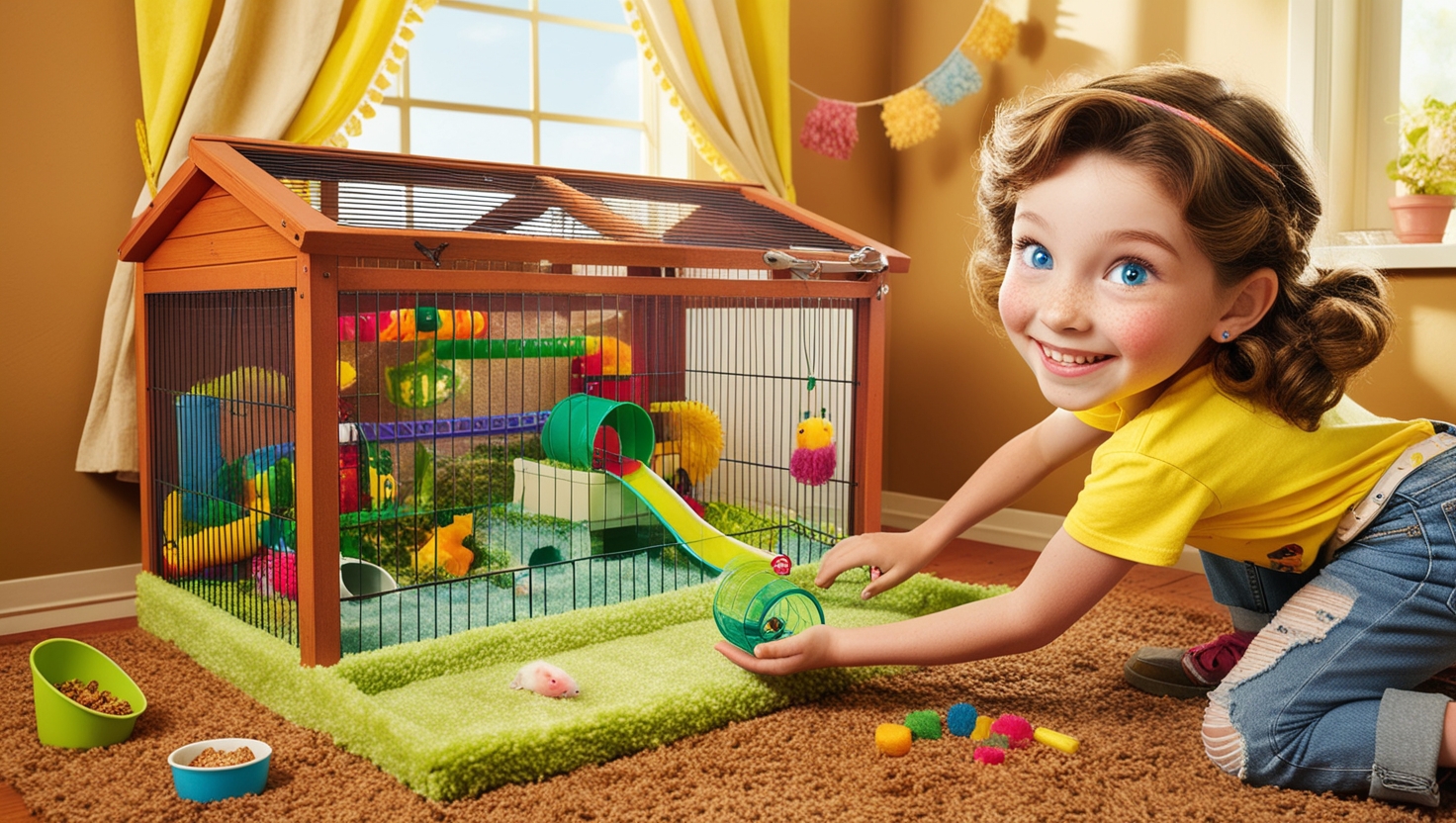Setting Up Hamsters Home – Best Guides & Care Sheet

3. Your hamster’s home
Don’t forget that you can’t buy a hamster without also buying a suitable home for your new furry friend to live in.
If you decide that you prefer a Syrian hamster then you are, of course, going to have to buy a larger cage than you would for a dwarf hamster. But there are other factors to consider too; you need to give a great deal of thought to exactly what type of home is best for the new addition to your family.
- Choosing a type of hamster
- Buying your hamster
- Your hamster’s home
- Feeding your hamster
- Getting to know your hamster
- Exercise
- Cleaning
- Health problems
The importance of cage size

Hamsters need to have plenty of space to run around; and that doesn’t mean a lot of pipes, it means actual floor space.
According to the National Hamster Council, a Syrian hamster should ideally have a cage that has floor space of at least 1000cm2 and a height of 19cm.
A dwarf hamster should have at least 750cm2 of floor space and a cage height of 17cm.
You should always make sure that the floor of the cage has a covering of at least 4cm depth of suitable bedding as hamsters love to burrow.
It’s important to note that it’s not a good idea to buy cedar or pine shavings for your pet as some hamsters can develop an allergic reaction which causes problems with their breathing. Find out more about hamster bedding.

Which is best, wire or plastic?
Wire and plastic cages are both popular forms of housing for hamsters, and they both have their advantages and disadvantages.
If you opt for a wire cage then your new pet won’t be short of somewhere to climb; and this is something that hamsters love to do. One thing you need to make sure of is that the wires are never more than half a centimetre apart as it can be dangerous if they are any wider apart; a hamster can become inquisitive and get stuck, especially a dwarf hamster. You should also never buy a cage that has a wire bottom, as this is not good for a hamster’s feet.
If you decide on a wire cage, make sure to use layers inside, so that if your hamster is climbing along the top of the cage, they don’t have too far to fall if they lose their grip. This stops your pet from hurting themselves. It’s especially important to have regard to this when your hamster is a baby as they can get seriously hurt if they fall from a high level.
There are many plastic moulded hamster cages on the market today. These hamster homes are very easy to clean, and they offer protection to your little friend, if you have other pets in your home. Many of these cages have a small area of wire which can act as a climbing frame for your hamster. If you buy a cage that doesn’t have somewhere for you hamster to climb, you need to make sure that you provide a climbing frame in the cage for them so they are free to climb whenever they want to.
One very important thing to remember about a hamster cage is that it needs to be escape proof. You would be amazed at how adept these adorable looking creatures can be at making a bid for freedom!
Make sure that there are no gaps your pet can squeeze through, and always check that doors are completely secure. If they are in any way loose there is a good chance that your resourceful little hamster will be able to open them.
Why a modular system may not be a good idea
You’ve probably seen the brightly coloured hamster cages that consist of a collection of tubes joined together. It is not usually a good idea to house a hamster in one of these cages. There are several reasons for this. A hamster needs to have plenty of room to run around, and these cages don’t have that; running up and down tubes is not the same thing. It’s important for your pet to have plenty of floor space available.
It’s also easy for a hamster to get stuck in the tubes; especially if you have a Syrian hamster. Lastly, if your hamster is a little timid it may decide to hide out in the tubes and you’ll spend a lot of time having to dismantle the tubes, in order to reach your pet. This is not an appealing prospect.

The importance of toys
One very important thing that you need to remember, when you’re setting up a home for your hamster, is toys. Hamsters love to have something to keep them occupied; a wheel on its own isn’t enough.
As well as the usual hamster wheel you need to provide a selection of other toys, such as wooden chew toys. These toys are an excellent choice as they provide a fun activity for your hamster whilst, at the same time, stopping their teeth from becoming overgrown.
You need to make sure that you only give your pet wood that is safe, and not treated with pesticides. Cardboard is also a favourite with hamsters. You can get pet friendly cardboard rolls from retailers if you are concerned about the glue and ink which may be present in common household cardboard items.
One very important item in a hamster’s cage is somewhere for them to hide away; like a specially made hamster house. Your pet will want a place to escape to, especially for daytime sleeping, so you need to provide this for them. A word of warning, with any plastic items in your hamster’s cage you need to keep an eye on your pet’s interaction with the item. If your hamster starts to chew and swallow the plastic, this is bad for them.

Having a ball!
One of the main toys that a lot of people buy when they first get a hamster, is a hamster ball. Most people have probably seen the brightly coloured plastic orbs careering around someone’s floor, run only on hamster power.
Most hamsters will happily use a hamster ball, although you should never force your pet to do so if they seem reluctant. We’ll look at using a hamster ball in more detail when we consider the exercise your new hamster will need. Suffice to say that most of these cuddly rodents will enjoy tearing around your home in a ball, so it’s probably a good idea to include one on your shopping list.
Remember the essentials
There isn’t much point in having a cage, and a lot of toys if you haven’t got any food and water containers! Remember to buy a small food bowl for your hamster, as well as a drinking bottle.

What about the journey home?
You may not actually pay much thought to it prior to buying your pet, but you really do need to know how you are going to transport them home. A lot of pet stores put small animals like hamsters in a cardboard box for the journey. The problem with this is that hamsters love to chew, so you may just find you have an unwanted guest on the car dashboard if you don’t keep an eye on the box all the way home!
If you want to guard against any incidents it may be worth investing in a small pet carrier, as they are a lot more secure. Of course you can also use the carrier for any future visits to the vet as well, and for temporary housing for your hamster while you do the weekly cage clean.
- Choosing a type of hamster
- Buying your hamster
- Your hamster’s home
- Feeding your hamster
- Getting to know your hamster
- Exercise
- Cleaning
- Health problems
Setting Up Your Hamster’s Home: FAQs
Bringing home a hamster is exciting! Here are some frequently asked questions about setting up their habitat to ensure a happy and healthy life for your new furry friend:
What type of cage is best for a hamster?
The best cage options depend on your hamster’s species:
Syrian Hamsters: Need a spacious cage with a minimum of 450 square inches of floor space, but bigger is always better. Glass tanks, wire cages with solid bases (no wire floors!), or plastic modular cages are all suitable.
Dwarf Hamsters (Campbell’s, Winter White, Roborovski): Require at least 450 square inches of unbroken floor space, though more is recommended, especially for groups. Wire cages with bar spacing close enough together to prevent escapes (or covered with mesh), glass tanks, or plastic modular cages are suitable.
Important Considerations:
Ventilation: Good airflow is crucial. Avoid solid-top enclosures for adequate ventilation.
Security: Ensure the cage is escape-proof with secure latches and no gaps.
Ease of Cleaning: Choose a cage that is easy to access for cleaning and changing bedding.
What kind of bedding should I use?
Safe and comfortable bedding options include:
Aspen Shavings: A popular choice, but ensure it’s dust-free.
Paper-Based Bedding: Soft, absorbent, and available in various textures.
Hemp Bedding: Absorbent and environmentally friendly.
Avoid:
Cedar or Pine Shavings: Contain harmful oils that can cause respiratory problems.
Scented Bedding: Can irritate a hamster’s sensitive respiratory system.
How often should I clean my hamster’s cage?
Spot clean the cage daily by removing soiled bedding and leftover food. A full bedding change and cage cleaning should be done once a week or more frequently if needed.
Where should I place my hamster’s cage?
Choose a location:
Away from direct sunlight: To prevent overheating.
In a quiet area: Away from loud noises and vibrations.
With stable temperatures: Avoid extreme heat or cold.
Can I put toys and accessories in my hamster’s cage?
Yes, providing enrichment is essential! Choose safe and stimulating toys like:
Chew toys: Help keep their teeth trimmed.
Climbing toys: Ladders, platforms, and branches offer climbing opportunities.
Tunnels and Hideouts: Provide a sense of security and encourage exploration.
Q: What other items do I need in my hamster’s cage?
Essentials include:
Food Dish: A shallow, heavy dish to prevent tipping.
Water Bottle: A drip-proof bottle with a fresh water supply.
Exercise Wheel: Choose a solid-surface wheel large enough for your hamster to run comfortably without arching its back.
Hideout: At least one hideout where your hamster can feel secure and sleep.
Chew Toys: Wooden chews, cardboard tubes, and other safe materials help wear down their constantly growing teeth.
Remember to introduce new items gradually and always supervise your hamster during playtime.
By following these guidelines, you can create a safe, comfortable, and enriching environment for your hamster to thrive!
